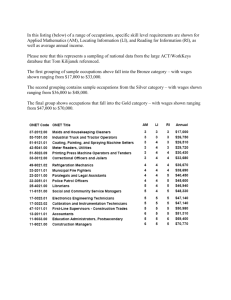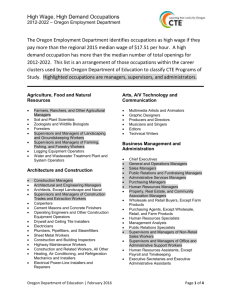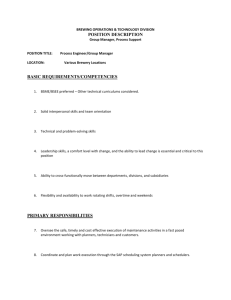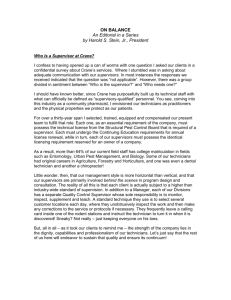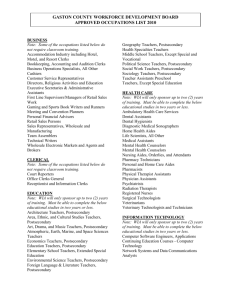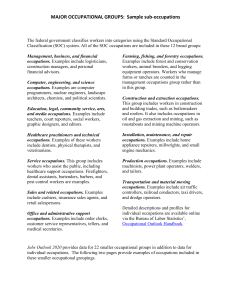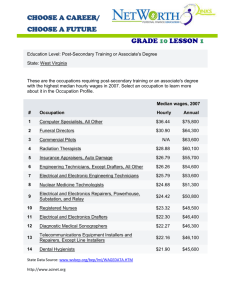Estimations for Job Growth in the Tertiary and Quaternary Sectors in
advertisement
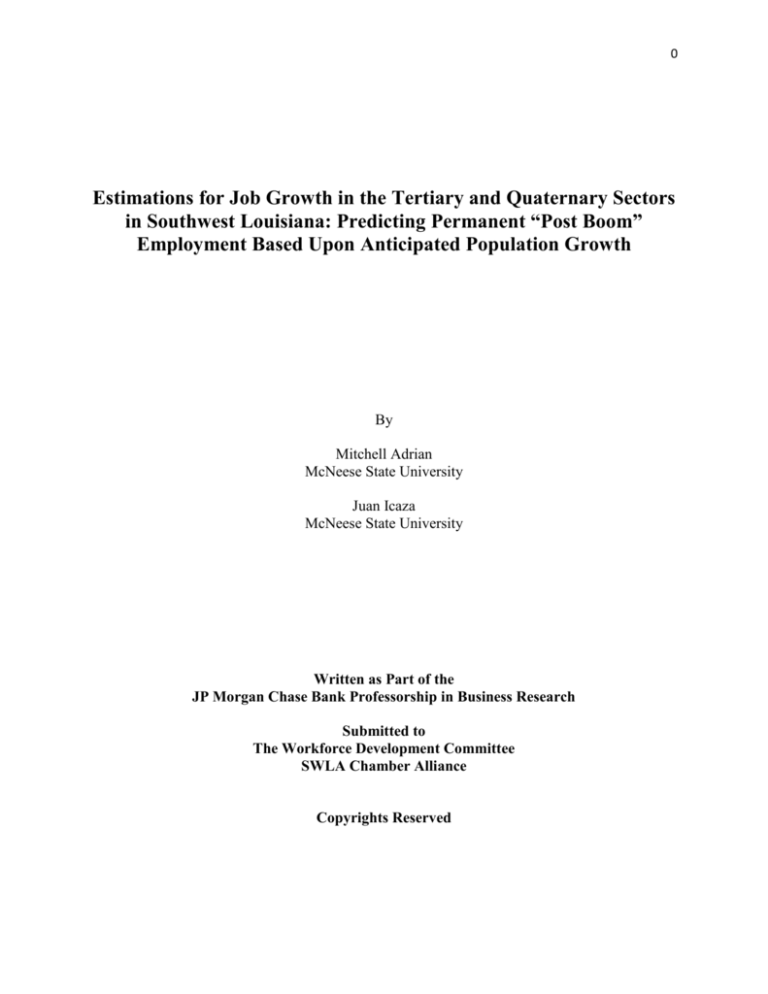
0 Estimations for Job Growth in the Tertiary and Quaternary Sectors in Southwest Louisiana: Predicting Permanent “Post Boom” Employment Based Upon Anticipated Population Growth By Mitchell Adrian McNeese State University Juan Icaza McNeese State University Written as Part of the JP Morgan Chase Bank Professorship in Business Research Submitted to The Workforce Development Committee SWLA Chamber Alliance Copyrights Reserved 1 Estimations for Job Growth in the Tertiary and Quaternary Sectors in Southwest Louisiana: Predicting Permanent “Post Boom” Employment Based Upon Anticipated Population Growth Introduction The five-parish region of Louisiana consisting of Allen, Beauregard, Calcasieu, Cameron, and Jeff Davis parishes is a recognized metropolitan area commonly referred to as Southwest Louisiana (SWLA). As reported in the 2010 U.S. census, the region claims a population of over 292,000 (Table 1).8 The primary industrial, business and population center is in and around the city of Lake Charles (in Calcasieu Parish) and the major industries in the region include agriculture and livestock, forestry, fishing, oil and natural gas production and petroleum and chemical refining. Table 1 – Regional Population and Civilian Employment Civilian Parish Population Employment (over 16yr of age) Allen 25,740 8,616 Beauregard 35,662 14,184 Calcasieu 192,307 84,668 Cameron 6,934 3,284 Jefferson Davis 31,529 12,011 292,172 122,763 Greatly impacted by Hurricane Rita in 2005, SWLA prospered as local reconstruction efforts helped offset national economic declines and a collapse of the housing market. Recent technological breakthroughs in oil and natural gas extraction and refinement are now driving economic activity for the region with considerable growth predicted in the short to mid-term future. Given that this region is highly dependent upon the oil and the natural gas industry, local leaders have witnessed previous eras of “boomtown” growth, many with long-term “busts” following the “boom.” As a result, area leaders and educational institutions are attempting to coordinate efforts to help the region meet future workforce requirements in a way that can stabilize long-term employment in the region. Specific objectives include a high utilization of the existing workforce and the support of long-term economic growth after the initial construction phase or “economic boom.” Preparation thus far has centered largely on the workforce needs of the primary and secondary employment sectors (notably the petrochemical industry and related industries). These needs have been mostly identified as part of each organization’s strategic plan and human resource planning efforts. Human resource needs have been communicated to educational and training institutions and efforts made to encourage sufficient enrollment and to align training and educational activities with regional resource needs. 2 What has been more difficult for educational institutions is predicting workforce needs in the tertiary and quaternary employment sectors as a result of the economic expansion and population growth. Businesses in these sectors are primarily in a reactionary position, as they are unable to accurately forecast employment needs by function. Educational and training institutions are in a reactionary position as well, as they too find it difficult to predict jobs growth and training needs in such types of markets. This report is an attempt to provide a reasonable forecast of potential employment needs in tertiary and quaternary markets in a ‘post boom” SWLA economy. Economic Sectors A nation’s economy can be divided into various sectors for the purpose of categorizing labor and work activity. The five basic sectors are 1) Primary, 2) Secondary, 3) Tertiary, 4) Quaternary, and 5) Quinary. Work in the primary sector extracts or harvests products from the earth. This sector includes the production of raw materials and basic foods. Activities associated with the primary sector include agriculture, mining, forestry, fishing and quarrying. The packaging and processing of the raw material associated with this sector is also considered to be part of this sector. Work in the secondary sector manufactures finished goods. All of manufacturing, processing, and construction lies within the secondary sector. This includes automobile production, chemical and engineering industries, energy utilities and construction. The tertiary sector of the economy is the service industry. This sector provides business-tobusiness and business-to-consumer services. Activities associated with this sector include retail and wholesale trades, transportation and distribution, entertainment, restaurants, clerical services, media, tourism, insurance, banking, healthcare, and law. The quaternary sector consists of intellectual activities. Activities associated with this sector include government, culture, libraries, scientific research, education, and information technology. The quinary sector is often considered a branch of the quaternary sector. The quinary sector includes top executives or officials in such fields as government, science, universities, nonprofits, healthcare, and the media. Industry Growth in SWLA Planned industry growth in Southwest Louisiana (SWLA) includes $65 billion in capital investment and is highlighted by the following project investments: 3, 5 Belle Savanne - $230 million capital investment 3 Big Lake Fuels - $1.3 billion capital investment Boise Inc. - $113 million capital investment BP Biofuels - $400 million capital investment CB&I/Shaw Modula Solutions - $100 million capital investment Cheniere Energy - $20 billion capital investment Coushatta Casino Resort - $60 million capital investment Golden Nugget/Pinnacle/Ameristar - $580 million capital investment IFG Port Holding/New Grain Terminal - $59.5 million capital investment Juniper GTL - $100 million capital investment Lake Charles Clean Energy (Leucadia) - $2.6 billion capital investment Lake Charles LNG (Trunkline LNG Export) - $9 billion capital investment Lakes at Morganfield - $350 million capital investment Leucadia National Corporation/LC Cogeneration - $2.6 billion capital investment Magnolia LNG - $3.5 billion capital investment National Hurricane Museum - $66 million capital investment SASOL Ethylene Tetramerization - $175 million capital investment SASOL GTL & Derivatives - $16 billion capital investment Sempra/Cameron LNG - $9 billion capital investment Virtual Engineering Operations VEOPS - $100 million capital investment The subtotal of projected capital investments is over $65 billion. It is anticipated that over 31,000 construction workers will be employed during peak construction years, expected to end between 2018 and 2020.4,5 A more specific projection of workforce needs includes the following: 4,5 New Construction Jobs New Permanent/Direct Jobs New Permanent/Indirect Jobs New Permanent/Induced Jobs 31000+ 6300+ 6300+ 6200+ After construction is completed, as many as 18,000+ new permanent jobs will be added to the primary and secondary employment sectors to accommodate new production. New employment opportunities typically equate to population growth, as workers and their families move into the area to take advantage of the growing economy. It is predicted that the five-parish area classified as “Southwest Louisiana” may have as many as 50,000 new residents by the year 2020.2 Estimations of Added Jobs and Population Increase The term “industries” in SWLA is often used to describe the activities associated with the primary and secondary sectors, notably 1) chemical plants, 2) refineries, and 3) natural gas processing plants. In addition, those businesses directly supporting petrochemical operations (maintenance, equipment repair, etc.) are often classified as part of the overall “industry” mix. Other major industries in the region include aviation and nuclear energy construction. 4 The planned capital investment and industrial growth in SWLA includes human resource planning with relatively detailed predictions of workforce needs and employee skills. What is less known are the workforce needs in the tertiary and quaternary sectors. In the U.S., more than 80% of the labor force is in the tertiary sector. Regional planners, educational institutions, and vocational training facilities have long provided the education and specific training needed by our regional workforce. Collaborations between industries in the primary/secondary sectors with regional educational and training facilities are in place and have shown success. However, the educational and training needs to satisfy growth in the tertiary and quaternary sectors is more difficult to predict when compared to growth in primary and secondary sectors, as this growth is not part of the planned expansion but rather the by-product of expansion and population growth. Predictive Models for Tertiary and Quaternary Employment Predictive models for tertiary employment were found to be relatively limited. A model designed by Thompson and Black6 and later validated by Thompson and Stollar7 utilizes the variables of 1) per capita income, 2) percentage of the populations in urban areas, 3) life expectancy at birth, 4) tourist expenditure per capita, and 5) labor force participation rates.6,7 This model was designed to have international applications in predicting employment levels in the tertiary or service sectors of an economy. What may be most notable from the Thompson/Black6 model and applicable to the SWLA region are the relative influence of per capita income and labor force participation rates. The influx of new jobs to SWLA is likely to increase per capita income as the majority of new jobs are expected to pay at levels above the current median income for the region.4 What is not known is if there will be any change to the current labor participation rate. It is also assumed that the degree of urbanization, life expectancy, and tourist expenditures per capita will remain relatively unchanged through this period of growth. After evaluating the Thompson/Black6 model, it was concluded that data for the for the SWLA region relevant to the model is not easily accessible. It was also concluded that a more simple and easily applicable model is desired. In order to provide a rough estimate of future employment needs in the tertiary and quaternary sectors, this report develops two simple models to predict jobs growth. The models are based on the assumption that industry growth leads to population growth and the increased population leads to growth in the tertiary and quaternary sectors. Model 1 - The first model is a peer group estimate. It is based upon employment data from other metropolitan areas with a population size similar to that which is predicted to reside in SWLA after the “post boom” growth. This model assumes a logical relationship between the number of people living in a geographic area and the number of job specializations required to service the population. Thus the formula for Model 1 is as follows: 5 Model 1: FE = PE PME Where: FE = Future Employment per job category PE = Employment per job category for post-growth peers PME = Peer metropolitan areas (post local growth) Model 2 – The second predictive model calculates employment on a per-capita basis and applies this ratio to the assumed future population. A formula for each job category is created that develops the ratio for the number of jobs per current level of population. As population predictions increase, this ratio thus predicts the number of jobs required to service a larger population given the same ratio of current “jobs per population.” Thus the formula for Model 2 is as follows: Model 2: CR = CE CP FE = CR x GP Where: FE = Future Employment per job category CR = Current Ratio of employment per category CE = Current Employment per job category CP = Current Population GP = Growth Population (expected future population size) The two-model approach provides both potential advantages and potential weaknesses in estimating employment growth. Probable limitations include: Each metropolitan area may have a unique industry base that, in turn, skews or biases the number of jobs in those specific areas. For example, the petrochemical industry in SWLA is not replicated in most of the other metropolitan areas in the study. Each metropolitan area will have a unique culture and population base, influencing demand in various markets of the tertiary and quaternary sectors. As noted in the Thompson/Black model, variations of per capita income, urban density, and labor force participation rates may create significant variances among tertiary employment within the peer regions used in the study. 6,7 Model 1 - Data Collection and Comparison Process Based on 2010 census data, the population for the five-parish region of Southwest Louisiana (SWLA) is approximately 292,000 persons.8 Based on an assumed growth of about 50,000 people2, a “post growth” permanent population of approximately 342,000 is the baseline for this study. To make a comparison, metropolitan areas in the US ranging in population between 330,000 and 360,000 were selected (10 metropolitan areas were found). Those areas selected are: 6 1. Ann Arbor MI 2. Eugene, OR 3. Hickory-Lenoir-Morganton, NC 4. Huntington-Ashland, WV-KY-OH 5. Kalamazoo-Portage, MI 6. Naples-Immokalee-Marco Island, FL 7. Ocala, FL 8. Rockford, IL 9. Savannah, GA 10. Trenton, NJ With data taken from The Bureau of Labor Statistics9, the number of jobs listed in each of the provided job categories from these ten metropolitan areas was collected and averaged. This average is presumed to represent the potential number of jobs likely to be required in SWLA given the potential population growth of the region (Tables 2 and 3, Comparison Model Prediction). Model 2 - Overall Predictions and Development of Per-Capita Rules of Thumb Given the variations in regional employment and the affects of cultural and industrial variation on employment needs, a second method of “jobs per capita” was also calculated. Using current employment numbers, the per capita number of jobs given the existing population was set as the base measure. This formula is then adjusted for the expected increase in population of approximately 342,000 persons (Tables 2 and 3, Per Capita Model Predictions). Data for the two models was taken from the Louisiana Workforce Commission Occupational Wage Data 20121 and the United States Department of Labor Bureau of Labor Statistics.9 Conclusion For those involved in workforce development, education, and training, forecasts in the tertiary and quaternary sectors are a needed tool. It is assumed that no single model will provide a perfect prediction, but it is hoped that these simple models will provide sufficient accuracy while also providing flexibility and ease of use as future population predictions are adjusted. It is hoped that the two proposed models will create a predictive range that is reasonably accurate and useful to those responsible for developing our future workforce. A few examples of employment predictions that may be of interest to regional training and education facilities likely include: Accountants and auditors Automotive service Technicians and Mechanics Bookkeeping, Accounting, and Auditing Clerks 7 Child Care Workers Combined Food Preparation and Serving Workers, Including Fast Food Dental Assistants Elementary School Teachers, Except Special Education Executive Secretaries and Administrative Assistants Hairdressers, Hairstylists, and Cosmetologists Home Health Aides Insurance Claims and Policy Processing Clerks Legal Secretaries Maintenance and Repair Workers, General Medical and health Services Managers Medical Records and Health Information Technicians Nurse Practitioners Nursing Assistants Paralegals and Legal Assistants Pharmacy Technicians Police and Sheriff’s Patrol Officers Postal Service Mail Carriers Registered Nurses Retail Salespersons In closing, such a large capital investment in the SWLA region ensures some measure of economic change. It is highly likely this change will include economic growth and a considerable increase in the permanent population. Increased industrial activity and a population increase will in-turn create a greater demand for the goods and services provided through the tertiary and quaternary markets, thus fueling growth in these markets. To prepare for this growth, two predictive models are combined to provide a suggested range of change to our regional employment markets. The comparison model for predicted change is limited by the fact that no two metropolitan areas are the same regarding culture, industry, and thus basic employment demands. The per-capita model fails to capture potential economies of scale as businesses grow and may thus provide an oversimplified and/or overstated expectation for jobs growth. It is hoped that the two models together can create a realistic range of expectations in jobs growth that are of benefit to planners, educators, and business managers in our region. It should also be noted many of the jobs listed in Tables 2 and 3 can be classified as part of both the tertiary and/or primary/secondary sectors. For example, an accountant may work at a public accounting firm (tertiary) or an accountant may work as a corporate accountant for a mining company (primary). Therefore, the jobs listed in Tables 2 and 3 were included as they may fit the tertiary/quaternary sectors and it is expected that the listed jobs are not included as part of the job requirements publicized by major industries in the region. 8 References 1. Louisiana Workforce Commission Occupational Wage Data 2012 http://www.laworks.net/LaborMarketInfo/LMI_WageDataMap2009toPresent.asp?Year= 2012 2. Schmidt, Theresa (2013) “Go Group Plans for Economic Boom, KPLC TV, Posted Sept. 27, 2013. http://www.kplctv.com/story/23553234/go-group-plans-for-lc-economic-boom 3. SWLA Chamber Report, 2013, compiled by the Research Director of the Southwest Louisiana Economic Development Alliance, August 22, 2013. 4. SWLA Chamber Report, 2013, 2012-2018 SWLA Estimated Workforce Needs Report 8.22.13 5. SWLA Chamber Projects Report, 2012-2019, Updated 4.4.14. 6. Thompson, G. R. and Black, H. (1975) The Relationship between Labor Force Participation and Service Sector Employment, Journal of Regional Science. 15, 61-65. 7. Thompson, G. R. and Stollar, A. J. (1983) An Empirical Test of an International Model of Relative Tertiary Employment, Economic Development and Cultural Change. 31, 4, 775-785. 8. U.S. Department of Commerce Census Bureau: www.census.gov/easystats/ 9. U.S. Department of Labor Bureau of Labor Statistics http://www.bls.gov/oes/current/oes_29340.htm 9 Table 2 Comparison Models for Predicted Jobs Growth (Occupations Listed by Job Classification) SWLA Current Employment Comparison Model Prediction Per Capita Model Prediction 40 172 47 7 132 Sales Managers 140 296 164 24 156 Administrative Services Managers 160 292 187 27 132 60 302 70 10 242 190 490 222 32 300 Transportation, Storage, and Distribution Managers 60 88 70 10 28 Human Resources Managers 60 132 70 10 72 380 273 444 0 64 Education Administrators, All Other 30 60 35 5 30 Food Service Managers 90 191 105 15 101 Gaming Managers * 70 0 82 0 12 Medical and Health Services Managers 190 324 222 32 134 Postmasters and Mail Superintendents 30 40 35 5 10 160 170 187 10 27 80 147 93 13 67 120 383 140 20 263 Range of Change Management Occupations Marketing Managers Computer and Information Systems Managers Financial Managers Education Administrators, Elementary and Secondary School Property, Real Estate, and Community Association Managers Social and Community Service Managers Managers, All Other Business and Financial Management Occupations Wholesale and Retail Buyers, Except Farm Products Purchasing Agents, Except Wholesale, Retail, and Farm Products 30 89 35 5 59 170 311 199 29 141 Cost Estimators 160 179 187 19 27 Employment, Recruitment, and Placement Specialists * 120 0 140 0 20 Compensation, Benefits, and Job Analysis Specialists 30 90 35 5 60 Training and Development Specialists 60 189 70 10 129 Market Research Analysts 100 235 117 17 135 Business Operations Specialists, All Other 440 1283 514 74 843 Accountants and Auditors 650 990 760 110 340 70 184 82 12 114 240 209 280 0 40 Tax Examiners, Collectors, and Revenue Agents 30 82 35 5 52 Tax Preparers 40 68 47 7 28 Computer Systems Analysts 90 294 105 15 204 Information Security Analysts 30 120 35 5 90 Computer Programmers 90 353 105 15 263 Personal Financial Advisors Loan Officers Computer & Mathematical Occupations 10 SWLA Current Employment Comparison Model Prediction Per Capita Model Prediction Web Developers 30 98 35 5 68 Network and Computer Systems Administrators 70 281 82 12 211 Computer Network Support Specialists 80 94 93 13 14 Computer Occupations, All Other 30 259 35 5 229 Surveyors Health and Safety Engineers, Except Mining Safety Engineers and Inspectors 30 40 35 5 10 90 35 105 0 15 Architectural and Civil Drafters 80 69 93 0 13 Civil Engineering Technicians 120 88 140 0 20 60 54 70 0 10 Environmental Scientists and Specialists, Including Health 50 186 58 8 136 Biological Technicians 60 720 70 10 660 Life, Physical, and Social Science Technicians, All Other 30 1965 35 5 1935 290 0 339 0 49 Mental Health Counselors 50 151 58 8 101 Rehabilitation Counselors 50 113 58 8 63 Counselors, All Other 50 47 58 0 8 120 280 140 20 160 Mental Health and Substance Abuse Social Workers 90 136 105 15 46 Health Educators 40 56 47 7 16 Range of Change Architecture & Engineering Occupations Surveying and Mapping Technicians Life, Physical, & Social Science Occupations Community & Social Services Occupations Educational, Vocational, and School Counselors * Child, Family, and School Social Workers Probation Officers and Correctional Treatment Specialists 120 85 140 0 20 Social and Human Service Assistants 220 404 257 37 184 Community and Social Service Specialists, All Other 180 156 210 0 30 Lawyers 300 538 351 51 238 Paralegals and Legal Assistants 160 215 187 27 55 30 0 35 0 5 Vocational Education Teachers, Postsecondary 140 140 164 0 24 Kindergarten Teachers, Except Special Education 270 155 316 0 46 1280 1368 1496 88 216 720 713 841 0 121 1140 953 1332 0 192 Legal Occupations Title Examiners, Abstractors, and Searchers * Education, Training, & Library Occupations Elementary School Teachers, Except Special Education Middle School Teachers, Except Special and Vocational Education Secondary School Teachers, Except Special and Vocational Education Vocational Education Teachers, Secondary School * 150 0 175 0 25 Special Education Teachers, Preschool 120 300 140 20 180 11 SWLA Current Employment Comparison Model Prediction Per Capita Model Prediction Special Education Teachers, Kindergarten, and Elementary School 430 300 503 0 73 Special Education Teachers, Middle School 170 125 199 0 29 Special Education Teachers, Secondary School Adult Literacy, Remedial Education, and GED Teachers and Instructors* 250 174 292 0 42 30 0 35 0 5 Self-Enrichment Education Teachers 100 240 117 17 140 Librarians 140 156 164 16 24 Library Technicians 170 109 199 0 29 Instructional Coordinators 140 131 164 0 24 1060 1525 1239 179 465 50 258 58 8 208 Floral Designers 60 51 70 0 10 Graphic Designers 60 202 70 10 142 Public Relations Specialists 50 183 58 8 133 Photographers 30 43 35 5 13 Chiropractors 30 50 35 5 20 Dietitians and Nutritionists 40 81 47 7 41 390 351 456 0 66 Family and General Practitioners 80 156 93 13 76 Pediatricians, General 30 50 35 5 20 Surgeons 50 75 58 8 25 Physicians and Surgeons, All Other 70 380 82 12 310 Physician Assistants 30 139 35 5 109 Occupational Therapists 90 129 105 15 39 180 241 210 30 61 80 127 93 13 47 120 149 140 20 29 Teacher Assistants Education, Training, and Library Workers, All Other Range of Change Arts, Design, Entertainment, Sports, & Media Occupations Healthcare Practitioners & Technical Occupations Pharmacists Physical Therapists Respiratory Therapists Speech-Language Pathologists Veterinarians 40 76 47 7 36 Registered Nurses 2150 3759 2513 363 1609 Nurse Anesthetists 40 80 47 7 40 Nurse Practitioners 80 138 93 13 58 Medical and Clinical Laboratory Technicians 100 189 117 17 89 Medical and Clinical Laboratory Technologists 190 144 222 0 32 Cardiovascular Technologists and Technicians 90 118 105 15 28 Diagnostic Medical Sonographers 40 76 47 7 36 Nuclear Medicine Technologists 30 50 35 5 20 12 SWLA Current Employment Comparison Model Prediction Per Capita Model Prediction Radiologic Technologists and Technicians 210 266 245 35 56 Emergency Medical Technicians and Paramedics 270 285 316 15 46 Dietetic Technicians * 30 0 35 0 5 Pharmacy Technicians 370 441 432 62 71 Surgical Technologists 100 114 117 14 17 40 116 47 7 76 1260 699 1473 0 213 Veterinary Technologists and Technicians Licensed Practical and Licensed Vocational Nurses Medical Records and Health Information Technicians Range of Change 180 205 210 25 30 Opticians, Dispensing 60 84 70 10 24 Health Technologists and Technicians, All Other 30 123 35 5 93 Occupational Health and Safety Specialists 80 117 93 13 37 Healthcare Practitioners and Technical Workers, All Other 50 57 58 7 8 Home Health Aides 740 1021 865 125 281 Psychiatric Aides 150 320 175 25 170 Healthcare Support Occupations Nursing Assistants 1540 1816 1800 260 276 Physical Therapist Aides 90 85 105 0 15 Physical Therapist Assistants 90 79 105 0 15 Dental Assistants 220 317 257 37 97 Medical Assistants 400 694 467 67 294 Medical Equipment Preparers 30 83 35 5 53 Medical Transcriptionists 70 101 82 12 31 Veterinary Assistants and Laboratory Animal Caretakers 80 97 93 13 17 Phlebotomists 160 118 187 0 27 Healthcare Support Workers, All Other 100 150 117 17 50 First-Line Supervisors/Managers of Correctional Officers 130 83 152 0 22 First-Line Supervisors/Managers of Police and Detectives First-Line Supervisors/Managers of Fire Fighting and Prevention Workers First-Line Supervisors/Managers, Protective Service Workers, All Other 170 133 199 0 29 100 73 117 0 17 40 87 47 7 47 Fire Fighters 330 321 386 0 56 1000 775 1169 0 169 Detectives and Criminal Investigators 220 101 257 0 37 Police and Sheriff's Patrol Officers 840 575 982 0 142 1010 873 1180 0 170 120 130 140 10 20 60 148 70 10 88 Protective Service Occupations Correctional Officers and Jailers Security Guards Crossing Guards Lifeguards, Ski Patrol, and Other Recreational Protective Service Workers 13 SWLA Current Employment Comparison Model Prediction Per Capita Model Prediction Chefs and Head Cooks First-Line Supervisors/Managers of Food Preparation and Serving Workers 130 120 152 0 22 930 880 1087 0 157 Cooks, Institution and Cafeteria 440 418 514 0 74 Cooks, Restaurant 600 1321 701 101 721 Cooks, Short Order 450 150 526 0 76 2090 Range of Change Food Preparation & Serving Related Occupations Food Preparation Workers 901 2443 0 353 Bartenders Combined Food Preparation and Serving Workers, Including Fast Food Counter Attendants, Cafeteria, Food Concession, and Coffee Shop 650 540 760 0 110 1320 3286 1543 223 1966 400 526 467 67 126 Waiters and Waitresses 2460 2716 2875 256 415 Food Servers, Nonrestaurant 80 283 93 13 203 Dining Room and Cafeteria Attendants and Bartender Helpers 330 336 386 6 56 Dishwashers 300 584 351 51 284 Hosts and Hostesses, Restaurant, Lounge, and Coffee Shop 200 378 234 34 178 30 120 35 5 90 110 178 129 19 68 Food Preparation and Serving Related Workers, All Other Building & Grounds Cleaning, & Maintenance Occupations First-Line Supervisors/Managers of Housekeeping and Janitorial Workers First-Line Supervisors/Managers of Landscaping, Lawn Service, and Groundskeeping Workers Janitors and Cleaners, Except Maids and Housekeeping Cleaners 60 157 70 10 97 1560 2056 1823 263 496 Maids and Housekeeping Cleaners 1190 1023 1391 0 201 460 1100 538 78 640 30 70 35 5 40 Landscaping and Groundskeeping Workers Pesticide Handlers, Sprayers, and Applicators, Vegetation Personal Care & Service Occupations Gaming Supervisors * 390 0 456 0 66 First-Line Supervisors/Managers of Personal Service Workers 100 155 117 17 55 1240 0 1449 0 209 120 315 140 20 195 Entertainment Attendants and Related Workers, All Other * 30 0 35 0 5 Funeral Attendants 40 60 47 7 20 Morticians, Undertakers, and Funeral Directors * 40 0 47 0 7 190 371 222 32 181 Gaming Dealers * Amusement and Recreation Attendants Hairdressers, Hairstylists, and Cosmetologists Child Care Workers Personal and Home Care Aides * Fitness Trainers and Aerobics Instructors Recreation Workers 530 642 619 89 112 1320 0 1543 0 223 30 376 35 5 346 230 436 269 39 206 14 SWLA Current Employment Comparison Model Prediction Per Capita Model Prediction 1310 1362 1531 52 221 120 206 140 20 86 4090 3486 4780 0 690 Counter and Rental Clerks 290 438 339 49 148 Parts Salespersons 280 221 327 0 47 Retail Salespersons 3490 5042 4079 589 1552 Advertising Sales Agents 110 127 129 17 19 Insurance Sales Agents 310 303 362 0 52 Securities, Commodities, and Financial Services Sales Agents 110 301 129 19 191 Sales Representatives, Services, All Other Sales Representatives, Wholesale and Manufacturing, Except Technical and Scientific Products Sales Representatives, Wholesale and Manufacturing, Technical and Scientific Products 170 637 199 29 467 1030 1398 1204 174 368 Range of Change Sales & Related Occupations First-Line Supervisors/Managers of Retail Sales Workers First-Line Supervisors/Managers of Non-Retail Sales Workers Cashiers 170 281 199 29 111 Sales and Related Workers, All Other 100 155 117 17 55 Office & Administrative Support Occupations First-Line Supervisors/Managers of Office and Administrative Support Workers 850 1296 993 143 446 Switchboard Operators, Including Answering Service 180 133 210 0 30 Bill and Account Collectors 270 326 316 46 56 Billing and Posting Clerks and Machine Operators 380 494 444 64 114 Bookkeeping, Accounting, and Auditing Clerks 1490 1577 1741 87 251 Gaming Cage Workers * 220 0 257 0 37 Payroll and Timekeeping Clerks 240 162 280 0 40 50 61 58 8 11 Tellers 710 592 830 0 120 Court, Municipal, and License Clerks 140 204 164 24 64 30 60 35 5 30 710 2538 830 120 1828 Procurement Clerks Credit Authorizers, Checkers, and Clerks Customer Service Representatives Eligibility Interviewers, Government Programs 80 117 93 13 37 File Clerks 140 140 164 0 24 Hotel, Motel, and Resort Desk Clerks 220 259 257 37 39 Interviewers, Except Eligibility and Loan 80 323 93 13 243 Loan Interviewers and Clerks 60 125 70 10 65 New Accounts Clerks 80 92 93 12 13 Order Clerks 90 201 105 15 111 Human Resources Assistants, Except Payroll and Timekeeping 80 151 93 13 71 1110 1157 1297 47 187 40 60 47 7 20 Receptionists and Information Clerks Reservation and Transportation Ticket Agents and Travel Clerks 15 SWLA Current Employment Comparison Model Prediction Per Capita Model Prediction 150 267 175 25 117 90 67 105 0 15 Police, Fire, and Ambulance Dispatchers 100 112 117 12 17 Dispatchers, Except Police, Fire, and Ambulance 370 142 432 0 62 Meter Readers, Utilities 70 47 82 0 12 Postal Service Clerks 70 69 82 0 12 Postal Service Mail Carriers Postal Service Mail Sorters, Processors, and Processing Machine Operators 290 361 339 49 71 30 203 35 5 173 Production, Planning, and Expediting Clerks 100 316 117 17 216 Shipping, Receiving, and Traffic Clerks 320 689 374 54 369 1270 1881 1484 214 611 30 62 35 5 32 Executive Secretaries and Administrative Assistants 710 940 830 120 230 Legal Secretaries 210 228 245 18 35 Information and Record Clerks, All Other Couriers and Messengers Stock Clerks and Order Fillers Weighers, Measurers, Checkers, and Samplers, Recordkeeping Medical Secretaries Range of Change 90 536 105 15 446 2580 0 3015 0 435 40 90 47 7 50 Data Entry Keyers 110 197 129 19 87 Insurance Claims and Policy Processing Clerks 150 218 175 25 68 Mail Clerks and Mail Machine Operators, Except Postal Service 30 99 35 5 69 Office and Administrative Support Workers, All Other 30 314 35 5 284 2320 3333 2711 391 1013 630 450 736 0 106 Secretaries, Except Legal, Medical, and Executive * Computer Operators Office Clerks, General Installation, Maintenance, & Repair Occupations First-Line Supervisors/Managers of Mechanics, Installers, and Repairers Computer, Automated Teller, and Office Machine Repairers Telecommunications Equipment Installers and Repairers, Except Line Installers Electrical and Electronics Repairers, Commercial and Industrial Equipment 40 111 47 7 71 290 202 339 0 49 50 88 58 8 38 Aircraft Mechanics and Service Technicians 140 367 164 24 227 Automotive Body and Related Repairers 120 117 140 0 20 Automotive Service Technicians and Mechanics 460 629 538 78 169 Bus and Truck Mechanics and Diesel Engine Specialists 290 210 339 0 49 Mobile Heavy Equipment Mechanics, Except Engines 160 105 187 0 27 40 0 47 0 7 Tire Repairers and Changers Heating, Air Conditioning, and Refrigeration Mechanics and Installers 100 76 117 0 17 250 245 292 0 42 Maintenance Workers, Machinery 130 104 152 0 22 Motorcycle Mechanics * 16 SWLA Current Employment Comparison Model Prediction Per Capita Model Prediction 110 80 129 0 19 70 76 82 6 12 Maintenance and Repair Workers, General Coin, Vending, and Amusement Machine Servicers and Repairers 1750 1363 2045 0 295 110 55 129 0 19 Helpers--Installation, Maintenance, and Repair Workers 270 123 316 0 46 Electrical Power-Line Installers and Repairers Telecommunications Line Installers and Repairers Range of Change Production Occupations Bakers 130 175 152 22 45 Printing Press Operators 60 157 70 10 97 Print Binding and Finishing Workers 50 95 58 8 45 Laundry and Dry-Cleaning Workers 310 218 362 0 52 40 90 47 7 50 Packaging and Filling Machine Operators and Tenders 120 363 140 20 243 Transportation & Material Moving Occupations First-Line Supervisors/Managers of Transportation and MaterialMoving Machine and Vehicle Operators 220 201 257 0 37 Bus Drivers, School 660 508 771 0 111 Driver/Sales Workers 290 407 339 49 117 Truck Drivers, Heavy and Tractor-Trailer* 1690 0 1975 0 285 Truck Drivers, Light or Delivery Services* 670 0 783 0 113 70 139 82 12 69 280 274 327 0 47 50 93 58 8 43 Pressers, Textile, Garment, and Related Materials Taxi Drivers and Chauffeurs Cleaners of Vehicles and Equipment Refuse and Recyclable Material Collectors * There was no data for the comparison model 17 Table 3 Comparison Models for Predicted Jobs Growth (Occupations Listed Alphabetically) SWLA Current Employment Comparison Model Prediction Per Capita Model Prediction Accountants and Auditors 650 990 761 111 340 Administrative Services Managers 160 292 187 27 132 35 0 5 Adult Literacy, Remedial Education, and GED Teachers and Instructors* 30 Range of Change Advertising Sales Agents 110 127 129 17 19 Aircraft Mechanics and Service Technicians 140 367 164 24 227 Amusement and Recreation Attendants 120 315 141 21 195 Architectural and Civil Drafters 80 69 94 0 14 Assemblers and Fabricators, All Other 50 426 59 9 376 Automotive Body and Related Repairers 120 117 141 0 21 Automotive Service Technicians and Mechanics 460 629 539 79 169 Bakers 130 175 152 22 45 Bartenders 650 540 761 0 111 Bill and Account Collectors 270 326 316 46 56 Billing and Posting Clerks and Machine Operators 380 494 445 65 114 60 720 70 10 660 1,490 1577 1745 87 255 Bus and Truck Mechanics and Diesel Engine Specialists 290 210 340 0 50 Bus Drivers, School 660 508 773 0 113 Business Operations Specialists, All Other 440 1283 515 75 843 Captains, Mates, and Pilots of Water Vessels 270 103 316 0 46 90 118 105 15 28 4,090 3486 4790 0 700 Chefs and Head Cooks 130 120 152 0 22 Child Care Workers 530 642 621 91 112 Child, Family, and School Social Workers 120 280 141 21 160 30 50 35 5 20 Cleaners of Vehicles and Equipment 280 274 328 0 48 Coin, Vending, and Amusement Machine Servicers and Repairers 110 55 129 0 19 1,320 3286 1546 226 1966 180 156 211 0 31 Compensation, Benefits, and Job Analysis Specialists 30 90 35 5 60 Computer and Information Systems Managers 60 302 70 10 242 Biological Technicians Bookkeeping, Accounting, and Auditing Clerks Cardiovascular Technologists and Technicians Cashiers Chiropractors Combined Food Preparation and Serving Workers, Including Fast Food Community and Social Service Specialists, All Other 18 SWLA Current Employment Comparison Model Prediction Per Capita Model Prediction Computer Network Support Specialists 80 94 94 14 14 Computer Occupations, All Other 30 259 35 5 229 Computer Operators 40 90 47 7 50 Computer Programmers 90 353 105 15 263 Computer Systems Analysts 90 294 105 15 204 Computer, Automated Teller, and Office Machine Repairers 40 111 47 7 71 Cooks, Institution and Cafeteria 440 418 515 0 75 Cooks, Restaurant 600 1321 703 103 721 Cooks, Short Order 450 150 527 0 77 1,000 775 1171 0 171 160 179 187 19 27 50 47 59 0 9 Counter and Rental Clerks 290 438 340 50 148 Counter Attendants, Cafeteria, Food Concession, and Coffee Shop 400 526 468 68 126 90 67 105 0 15 140 204 164 24 64 Correctional Officers and Jailers Cost Estimators Counselors, All Other Couriers and Messengers Court, Municipal, and License Clerks Credit Authorizers, Checkers, and Clerks Range of Change 30 60 35 5 30 Crossing Guards 120 130 141 10 21 Customer Service Representatives 710 2538 832 122 1828 Data Entry Keyers 110 197 129 19 87 Dental Assistants 220 317 258 38 97 Detectives and Criminal Investigators 220 101 258 0 38 Diagnostic Medical Sonographers 40 76 47 7 36 Dietitians and Nutritionists 40 81 47 7 41 Dining Room and Cafeteria Attendants and Bartender Helpers 330 336 386 6 56 Dishwashers 300 584 351 51 284 Dispatchers, Except Police, Fire, and Ambulance 370 142 433 0 63 Driver/Sales Workers 290 407 340 50 117 30 60 35 5 30 380 273 445 0 65 50 258 59 9 208 340 0 50 Education Administrators, All Other Education Administrators, Elementary and Secondary School Education, Training, and Library Workers, All Other Educational, Vocational, and School Counselors * Electrical and Electronics Repairers, Commercial and Industrial Equipment Electrical Power-Line Installers and Repairers 290 50 88 59 9 38 110 80 129 0 19 19 SWLA Current Employment Comparison Model Prediction Per Capita Model Prediction 1,280 1368 1499 88 219 80 117 94 14 37 Emergency Medical Technicians and Paramedics 270 285 316 15 46 Employment, Recruitment, and Placement Specialists* 120 141 0 21 Elementary School Teachers, Except Special Education Eligibility Interviewers, Government Programs Environmental Scientists and Specialists, Including Health Range of Change 50 186 59 9 136 710 940 832 122 230 80 156 94 14 76 File Clerks 140 140 164 0 24 Financial Managers 190 490 223 33 300 Fire Fighters 330 321 386 0 56 First-Line Supervisors/Managers of Correctional Officers 130 83 152 0 22 First-Line Supervisors/Managers of Fire Fighting and Prevention Workers 100 73 117 0 17 First-Line Supervisors/Managers of Food Preparation and Serving Workers 930 880 1089 0 159 First-Line Supervisors/Managers of Housekeeping and Janitorial Workers 110 178 129 19 68 First-Line Supervisors/Managers of Landscaping, Lawn Service, and Grounds keeping Workers 60 157 70 10 97 First-Line Supervisors/Managers of Mechanics, Installers, and Repairers 630 450 738 0 108 First-Line Supervisors/Managers of Non-Retail Sales Workers 120 206 141 21 86 First-Line Supervisors/Managers of Office and Administrative Support Workers 850 1296 996 146 446 First-Line Supervisors/Managers of Personal Service Workers 100 155 117 17 55 First-Line Supervisors/Managers of Police and Detectives 170 133 199 0 29 First-Line Supervisors/Managers of Retail Sales Workers 1,310 1362 1534 52 224 220 201 258 0 38 First-Line Supervisors/Managers, Protective Service Workers, All Other 40 87 47 7 47 Fitness Trainers and Aerobics Instructors 30 376 35 5 346 Floral Designers 60 51 70 0 10 Food Preparation and Serving Related Workers, All Other 30 120 35 5 90 2,090 901 2448 0 358 80 283 94 14 203 Executive Secretaries and Administrative Assistants Family and General Practitioners First-Line Supervisors/Managers of Transportation and Material-Moving Machine and Vehicle Operators Food Preparation Workers Food Servers, No restaurant 20 Food Service Managers Funeral Attendants Gaming Cage Workers * Gaming Dealers * Gaming Managers * Gaming Supervisors * Graphic Designers SWLA Current Employment Comparison Model Prediction Per Capita Model Prediction 90 191 105 15 101 40 60 Range of Change 47 7 20 220 258 0 38 1,240 1452 0 212 70 82 0 12 390 457 0 67 60 202 70 10 142 190 371 223 33 181 Health and Safety Engineers, Except Mining Safety Engineers and Inspectors 90 35 105 0 15 Health Educators 40 56 47 7 16 Health Technologists and Technicians, All Other 30 123 35 5 93 Healthcare Practitioners and Technical Workers, All Other 50 57 59 7 9 Healthcare Support Workers, All Other 100 150 117 17 50 Heating, Air Conditioning, and Refrigeration Mechanics and Installers 250 245 293 0 43 Home Health Aides 740 1021 867 127 281 Hosts and Hostesses, Restaurant, Lounge, and Coffee Shop 200 378 234 34 178 Hotel, Motel, and Resort Desk Clerks 220 259 258 38 39 80 151 94 14 71 Hairdressers, Hairstylists, and Cosmetologists Human Resources Assistants, Except Payroll and Timekeeping Human Resources Managers 60 132 70 10 72 Industrial Truck and Tractor Operators 340 588 398 58 248 Information and Record Clerks, All Other 150 267 176 26 117 30 120 35 5 90 Inspectors, Testers, Sorters, Samplers, and Weighers 410 575 480 70 165 Instructional Coordinators 140 131 164 0 24 Insurance Claims and Policy Processing Clerks 150 218 176 26 68 Insurance Sales Agents 310 303 363 0 53 80 323 94 14 243 Information Security Analysts Interviewers, Except Eligibility and Loan Janitors and Cleaners, Except Maids and Housekeeping Cleaners 1,560 2056 1827 267 496 Kindergarten Teachers, Except Special Education 270 155 316 0 46 Landscaping and Grounds keeping Workers 460 1100 539 79 640 Laundry and Dry-Cleaning Workers 310 218 363 0 53 Lawyers 300 538 351 51 238 Legal Secretaries 210 228 246 18 36 Librarians 140 156 164 16 24 Library Technicians 170 109 199 0 29 21 SWLA Current Employment Comparison Model Prediction Per Capita Model Prediction 1,260 699 1476 0 216 Life, Physical, and Social Science Technicians, All Other 30 1965 35 5 1935 Lifeguards, Ski Patrol, and Other Recreational Protective Service Workers 60 148 70 10 88 Loan Interviewers and Clerks 60 125 70 10 65 240 209 281 0 41 1,190 1023 1394 0 204 30 99 35 5 69 1,750 1363 2050 0 300 Maintenance Workers, Machinery 130 104 152 0 22 Managers, All Other 120 383 141 21 263 Market Research Analysts 100 235 117 17 135 40 172 47 7 132 Medical and Clinical Laboratory Technicians 100 189 117 17 89 Medical and Clinical Laboratory Technologists 190 144 223 0 33 Medical and Health Services Managers 190 324 223 33 134 Medical Assistants 400 694 468 68 294 30 83 35 5 53 180 205 211 25 31 Medical Secretaries 90 536 105 15 446 Medical Transcriptionists 70 101 82 12 31 Mental Health and Substance Abuse Social Workers 90 136 105 15 46 Mental Health Counselors 50 151 59 9 101 Meter Readers, Utilities 70 47 82 0 12 720 713 843 0 123 Licensed Practical and Licensed Vocational Nurses Loan Officers Maids and Housekeeping Cleaners Mail Clerks and Mail Machine Operators, Except Postal Service Maintenance and Repair Workers, General Marketing Managers Medical Equipment Preparers Medical Records and Health Information Technicians Middle School Teachers, Except Special and Vocational Education Range of Change Morticians, Undertakers, and Funeral Directors * 40 47 0 7 Motorcycle Mechanics * 40 47 0 7 Network and Computer Systems Administrators 70 281 82 12 211 New Accounts Clerks 80 92 94 12 14 Nuclear Medicine Technologists 30 50 35 5 20 Nurse Anesthetists 40 80 47 7 40 Nurse Practitioners 80 138 94 14 58 Nursing Assistants 1,540 1816 1804 264 276 Occupational Health and Safety Specialists 80 117 94 14 37 Occupational Therapists 90 129 105 15 39 Office and Administrative Support Workers, All Other 30 314 35 5 284 2,320 3333 2717 397 1013 Office Clerks, General 22 Opticians, Dispensing Order Clerks SWLA Current Employment Comparison Model Prediction Per Capita Model Prediction 60 84 70 10 24 Range of Change 90 201 105 15 111 Packaging and Filling Machine Operators and Tenders 120 363 141 21 243 Paralegals and Legal Assistants 160 215 187 27 55 Parts Salespersons 280 221 328 0 48 Payroll and Timekeeping Clerks 240 162 281 0 41 30 50 35 5 20 Pediatricians, General Personal and Home Care Aides * 1546 0 226 Personal Financial Advisors 70 184 82 12 114 Pesticide Handlers, Sprayers, and Applicators, Vegetation 30 70 35 5 40 Pharmacists 390 351 457 0 67 Pharmacy Technicians 370 441 433 63 71 Phlebotomists 160 118 187 0 27 Photographers 30 43 35 5 13 Physical Therapist Aides 90 85 105 0 15 Physical Therapist Assistants 90 79 105 0 15 Physical Therapists 180 241 211 31 61 Physician Assistants 30 139 35 5 109 Physicians and Surgeons, All Other 70 380 82 12 310 Police and Sheriff's Patrol Officers 840 575 984 0 144 Police, Fire, and Ambulance Dispatchers 100 112 117 12 17 70 69 82 0 12 290 361 340 50 71 Postal Service Mail Sorters, Processors, and Processing Machine Operators 30 203 35 5 173 Postmasters and Mail Superintendents 30 40 35 5 10 Pressers, Textile, Garment, and Related Materials 40 90 47 7 50 Print Binding and Finishing Workers 50 95 59 9 45 Printing Press Operators 60 157 70 10 97 Probation Officers and Correctional Treatment Specialists 120 85 141 0 21 Property, Real Estate, and Community Association Managers 160 170 187 10 27 Psychiatric Aides 150 320 176 26 170 50 183 59 9 133 Postal Service Clerks Postal Service Mail Carriers Public Relations Specialists Radiologic Technologists and Technicians Receptionists and Information Clerks Recreation Workers Refuse and Recyclable Material Collectors 1,320 210 266 246 36 56 1,110 1157 1300 47 190 230 436 269 39 206 50 93 59 9 43 23 SWLA Current Employment Comparison Model Prediction Per Capita Model Prediction 2,150 3759 2518 368 1609 Rehabilitation Counselors 50 113 59 9 63 Reservation and Transportation Ticket Agents and Travel Clerks 40 60 47 7 20 Respiratory Therapists 80 127 94 14 47 Registered Nurses Retail Salespersons Range of Change 3,490 5042 4087 597 1552 Sales and Related Workers, All Other 100 155 117 17 55 Sales Managers 140 296 164 24 156 Sales Representatives, Services, All Other 170 637 199 29 467 1,030 1398 1206 176 368 170 281 199 29 111 Secondary School Teachers, Except Special and Vocational Education 1,140 953 1335 0 195 Secretaries, Except Legal, Medical, and Executive* 2,580 3022 0 442 Sales Representatives, Wholesale and Manufacturing, Except Technical and Scientific Products Sales Representatives, Wholesale and Manufacturing, Technical and Scientific Products Securities, Commodities, and Financial Services Sales Agents 110 301 129 19 191 1,010 873 1183 0 173 100 240 117 17 140 80 147 94 14 67 Social and Human Service Assistants 220 404 258 38 184 Special Education Teachers, Kindergarten, and Elementary School 430 300 504 0 74 Special Education Teachers, Middle School 170 125 199 0 29 Special Education Teachers, Preschool 120 300 141 21 180 Special Education Teachers, Secondary School 250 174 293 0 43 Speech-Language Pathologists 120 149 141 21 29 1,270 1881 1487 217 611 50 75 59 9 25 100 114 117 14 17 60 54 70 0 10 Security Guards Self-Enrichment Education Teachers Social and Community Service Managers Stock Clerks and Order Fillers Surgeons Surgical Technologists Surveying and Mapping Technicians Surveyors 30 40 35 5 10 180 133 211 0 31 Tax Examiners, Collectors, and Revenue Agents 30 82 35 5 52 Tax Preparers 40 68 47 7 28 Taxi Drivers and Chauffeurs 70 139 82 12 69 1,060 1525 1241 181 465 Team Assemblers 150 1516 176 26 1366 Telecommunications Equipment Installers and Repairers, Except Line Installers 290 202 340 0 50 Switchboard Operators, Including Answering Service Teacher Assistants 24 SWLA Current Employment Comparison Model Prediction Per Capita Model Prediction 70 76 82 6 12 Tellers 710 592 832 0 122 Tire Repairers and Changers 100 76 117 0 17 Telecommunications Line Installers and Repairers Range of Change Title Examiners, Abstractors, and Searchers * 30 35 0 5 Training and Development Specialists 60 189 70 10 129 Transportation, Storage, and Distribution Managers 60 88 70 10 28 1979 0 289 Truck Drivers, Heavy and Tractor-Trailer * 1,690 Truck Drivers, Light or Delivery Services * 670 785 0 115 Veterinarians 40 76 47 7 36 Veterinary Assistants and Laboratory Animal Caretakers 80 97 94 14 17 Veterinary Technologists and Technicians 40 116 47 7 76 140 140 164 0 24 176 0 26 2,460 2716 2881 256 421 Web Developers 30 98 35 5 68 Weighers, Measurers, Checkers, and Samplers, Recordkeeping 30 62 35 5 32 Wholesale and Retail Buyers, Except Farm Products 30 89 35 5 59 Vocational Education Teachers, Postsecondary Vocational Education Teachers, Secondary School* Waiters and Waitresses * There was no data for the comparison model 150
